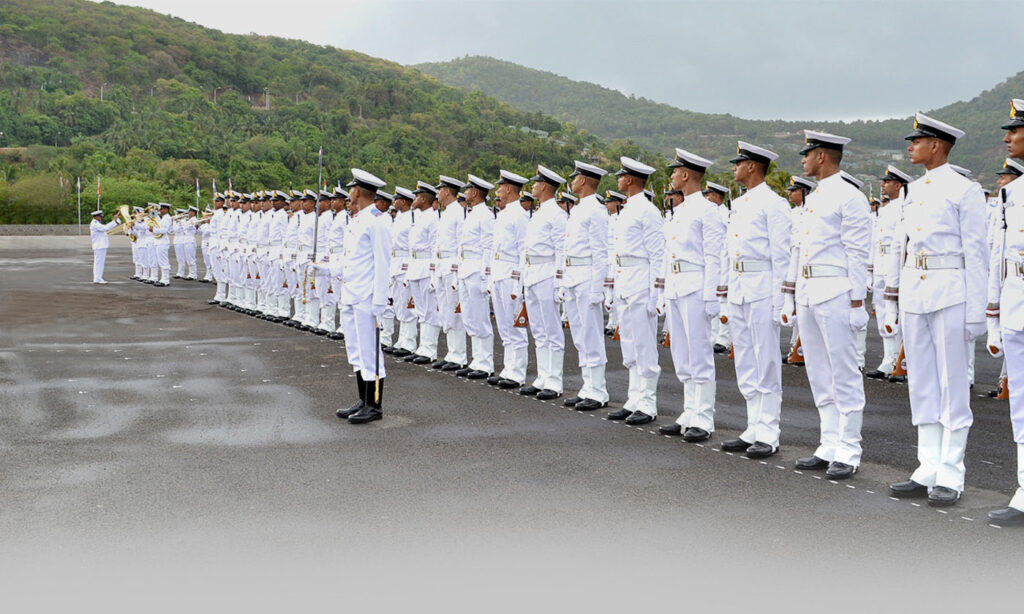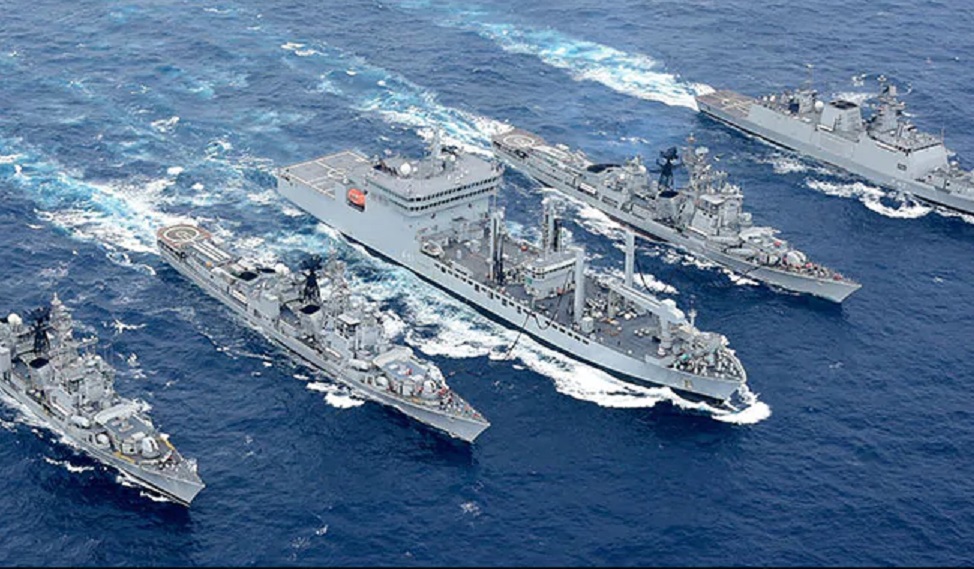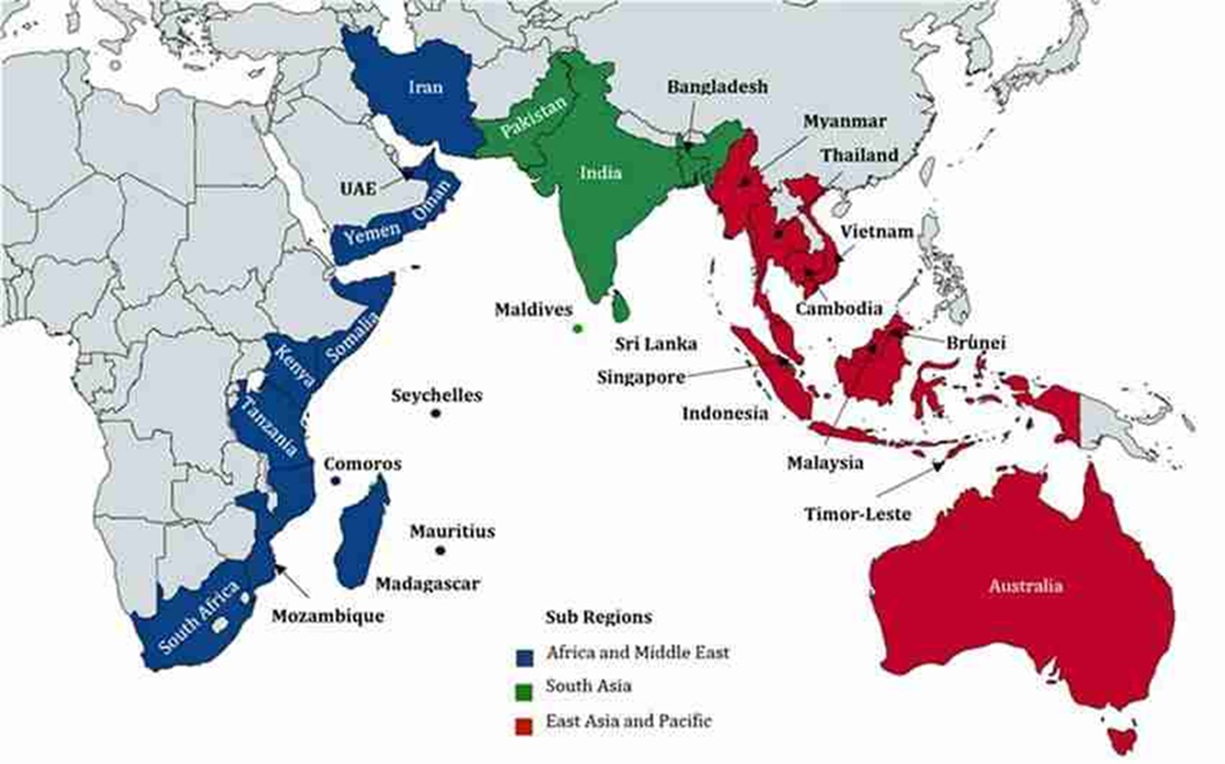Indian Navy’s long-held quest for an expansive and stronger role in the region came from an unexpected quarter. While leaving the Navy House at Kochi after attending a farewell dinner, Rear Admiral Wang Zhongcai of the Chinese Navy vigorously shook the hand of Vice Admiral Anil Chawla, the Flag Officer Commanding in Chief Southern Naval Command, and gushed, ‘we must ensure friendship, peace, tranquillity, and prosperity for all’. This was at the end of a symposium held at Kochi in 2018 to mark the 10th anniversary of IONS. The Chinese Admiral’s words reflected the narrative that had prevailed in private conversation as well as official statements by almost every one of the 96 Officers from 26 countries who had attended the four-day event. But there was one important nuance. Almost everyone who attended the event explicitly acknowledged India’s primacy in the IOR and exhorted India to do much more in order to maintain good order in the IOR.
Commentaries elsewhere too have echoed this sentiment. For instance, a 2018 Paper from CSIS, USA, states that ‘the Indo-Pacific is increasingly becoming a geostrategic focal point for China and India, as both countries engage in the growing competition. While China has aimed to secure access to strategic ports to gain an economic and strategic advantage, India’s role in the region is increasingly seen as a protector of the international order…..in the region, particularly as it pertains to maintaining open sea lanes and freedom of navigation. The Indian Navy remains the primary arm that enables India to shoulder this responsibility.
The Journey So Far
The Indian Navy has come a long way. From being kept out of the 1965 Indo Pak war to spectacular all-round brilliance in 1971 to massive expansion from the middle of the 1980s to regional interventions like Op Cactus in support of the Govt of the Maldives in 1988, to the massive Tsunami relief effort in the IOR in 2004 – 05, to steadily expanding exercises with an increasing number of foreign navies, to envisioning the IONS initiative in 2008, to a series of missions in support of the Indian diaspora in troubled areas abroad, to an Indian Prime Minister’s assertion in 2013 that India can be a net security provider the IOR, to the present times where the importance of our oceans for national prosperity is figuring increasingly in the Govt’s narrative, the Navy has indeed come a long way. It is essential that the momentum gained till now is put to good use, to build the capacity and capabilities that India needs, to realise our great potential to be a maritime power. Several obstacles need to be overcome for this.

Doctrinal Guidance
Recognising the importance of formal doctrinal documents to guide growth, the Navy started writing its Maritime Military Doctrine and Maritime Strategy from the middle of the 1980s. As doctrinal documents need to be dynamic, the Navy kept amending these with time and today we have excellent guiding documents. Doctrines reflect the professionalism with which states view their own security and hence these are made known to the world. Clearly enunciated Doctrines provide many advantages. But it is important that they are aligned to clearly thought out National Grand Strategy and National Security Strategy documents, for appearing credible to the world and to ourselves. They must flow from top to bottom, with everyone from the apex level sharing a common understanding of the nuances of ensuring national security. Here we have a problem. Shyam Saran, former Indian Foreign Secretary, had stated in 2019 that India ‘does not possess an overarching National Security Strategy that comprehensively assesses the challenges to the country’s security and spells out policies to deal effectively with them’. No report exists in the public domain about any change in the status quo on this. Further, in a Feb 2020 article titled ‘India’s Proposed Maritime Strategy’, Vice Admiral Pradeep Chauhan, Retd, DG National Maritime Foundation (DG NMF) lamented that a ‘draft National Maritime Policy (which encompasses India’s overarching strategy), is sadly, yet to be officially promulgated’. This lack of national-level policymaking is not helpful. There are other challenges too.
Steadily Increasing Threats
The world around us appears to be slipping into chaos. A belligerent China, led by a man who has amassed all the national powers for himself, continues to bring large parts of the world into China’s hard hold. Dependency bordering on vassalhood has been forced on several countries who made the error of accepting Chinese economic and military aid. China continues to interpret international law in whatever way that suits them and steadily militarises the South China Sea, not bothered by the legitimate claims raised by several countries that go by the tenets of accepted international agreements. They continue to confront India in India’s northern boundaries, threaten Taiwan with armed invasion and trample on human rights and democracy in Hong Kong, Tibet, and Xinjiang Uygur Autonomous Region. They also prop us Pakistan economically, diplomatically and militarily, for illegally allowing them to use territory legitimately claimed by India and for being a willing accomplice in needling India. China appears to be galloping along in the third decade of the 21st century, relatively less affected by the Covid pandemic compared to their prospective rivals in the rest of the world and focus their energies on strengthening their military force levels so as to challenge the established world order and emerge at the top. Ironically all this, while publicly declaring that they are rising from a century of humiliation and bullying.
To make matters worse for India in the maritime realm, the Chinese have re-oriented their military growth with sea power as one of the core areas for enhancement. With the frenetic building of Aircraft Carriers, Nuclear Submarines, other large surface ships, Maritime Aircraft, long-range weapons, satellite surveillance capability over ocean areas, and cyber capabilities, the PLA Navy is believed to have added force levels equalling twice the Indian Navy’s strength to themselves in the last decade alone. History has only grim lessons for such unilateral growth in force levels in the past.
Having sustained a flotilla of large ships in the western edges of the IOR for well over a decade for Anti Piracy patrols, the PLA Navy has gained both valuable experience in the Indian Ocean as well as great confidence in the ability of their ships to sustain pronged deployment at long distances. Further, the operational flexibility they have gained from having bases in Pakistan, Djibouti, and Sri Lanka for ready use appears to be poised for further enhancement with their continuing attempts to gain access to more bases in several other IOR countries.
Pakistan continues to relentlessly pursue its proxy war on India, despite debilitating poverty and internal troubles. The Pakistan Navy has steadily shed their British and American past in assets and has increasingly aligned their assets with the Chinese. Further, they have also increased military cooperation with Turkey, which has, of late emerged as an important manufacturer of military platforms and equipment. This could mean that PN might acquire disruptive new technology like armed Turkish UAVs of the kind which are believed to have played a decisive part in the recent Armenia – Azerbaijan war. An emerging Turkey – Iran – Pakistan alignment could also be indicative of Pakistan’s attempt to slowly distance themselves from Saudi Arabia, and consequently, from American influence. The crystallisation of this alignment would be serious trouble for India, especially the Indian Navy. Alliances, which can step up into the military realm in times of conflict, could be one important hedge for the future. But this would require much maturing.
Alliances
After twenty years of being in Afghanistan, first breaking up the place and then trying to put it back, the US is leaving indefinite defeat. The helpless state in which they are leaving the Afghan Govt and their military forces does not instil much confidence in their current and future allies. That the US is leaving for domestic political considerations, discarding pure military advice, is obvious. A US Govt that cannot choose the hard military options that have come to characterise US military interventions since World War I, appears to have been dented, with fallouts for future conflicts as part of coalitions. How much can prospective allies depend on a superpower that has apparently lost its stomach for a fight? Further, China’s deep economic linkages with the members of the QUAD and other countries that could join the QUAD as additional members may seriously limit the utility of these groupings in a conflict with China. One practical way the members of these groups can be of use to each other is to simultaneously present challenges to China in their individual capacities while exchanging information among the members of the group for coordinated action. This will spread Chinese capacities thin, across several fronts. A waypoint check is useful against this background.
Force levels
As per a Maritime Capability Perspective Plan, the Navy had envisioned a 200-ship fleet by 2027. However, this plan has faced many setbacks. An ORF Paper of Sep 2020, quoting a Public Accounts Committee report, a speech by the Chief of Naval Staff and other media reports, sums up that ‘Indian shipbuilding has fallen short of its promise. Over nearly the past decade, Indian shipyards have faced adverse conditions that have slowed down their warship construction. As a 2015 report of the Public Accounts Committee of the Parliament noted: “The extent to which Indian Navy shipbuilding projects are being delayed and the scale of underestimation reveals a deeper malaise. The report dealt with audit findings that highlighted inadequate shipbuilding practices, frequent mid-course changes, delays in the finalisation of weapon packages, and an underestimation of costs by shipyards. It noted that delays in the conclusion of contracts, lack of adequate infrastructure, non-finalisation of structural designs, and incompetent financial management, are merely symptomatic of a larger problem affecting the system. Indeed, India’s naval ship production endeavours have struggled to deliver results. Faced with various challenging conditions in recent years, shipbuilding programs have slowed down, with major private shipyards on the brink of a shutdown. Some are struggling to stay afloat and complete projects, overwhelmed by the huge time and cost overruns. Public shipyards, too, are facing headwinds. Despite credible accomplishments in the ‘Float’ and ‘Move’ categories of indigenous production, the lack of technology and equipment continues to affect the ‘Fight’ category, comprising weapons and sensors. Similarly, delays plague submarine force levels too. The 30-year submarine building plan envisaged for the period 2000 – 2030, was supposed to have produced 18 conventional and six nuclear submarines during that period. However, the actual accretion is likely to be only six Scorpenes and maybe one or two from the P75-I project. Serious shortages are most likely in the strength of utility helicopters too. All this is not great news.
A discussion that combines poorly with the above setbacks, is the one about a third Aircraft Carrier. On one hand, while India seems to increasingly understand and therefore acknowledge the importance of India’s oceans, as apparent from catchphrases and acronyms like Blue Economy and SAGAR, it is unfortunate that the utility of one of the most important symbols of maritime power, the Aircraft Carrier, is being doubted. It is even worse if the demand on the Navy is to choose between nuclear submarines and aircraft carriers. Budgetary constraints cannot lead to such illogical choices. All arguments that support the ‘future belongs to nuclear submarines’ view, empirically fail in the face of the frenetic pace at which the Chinese are building aircraft carriers. The Americans and even the not-so-rich British wouldn’t have been building aircraft carriers if they didn’t have utility in tomorrow’s world.
Sound, settled, command, and organisation structures are great force enablers and even force multipliers. The ongoing preparations to reorganise armed forces into Theatre Commands appear to have chinks. All arguments of the ‘look we have been thinking about it for too long, so let us go ahead and do something, start somewhere. We will fine-tune later as we go along, is fraught with dangers. Reforms for the sake of reforms may set us back, especially with major service-specific disagreements spilling out into the open.
Assurance of sustained funding is important for naval force building. Our challenges in this area are summed up well by RAdm Sudhir Pillai in a recent article in India Today, where he writes that ‘no plan on paper can achieve much without budgetary support. India’s economic growth has, however, stalled since 2017. The naval budget has been scaled back from 18 percent of the total defence budget in 2012-13 to 13.66 percent in 2018-19. The modernisation budget of the Navy has been scaled back from 8.7 percent in 2015-16 to 4.9 percent in 2018-19. The operational implication of these cuts needs close consideration. Navies the world over evolve by striking a balance between doctrinal roles and operational imperatives vis-a-vis fiscal reality. What is essential is to balance the necessities of maritime imperatives against continental strategies by apportioning budgetary support..’
Some Way Ahead
While the usual clamour for additional funding, National Security Document, the whole of Govt approach to thwart attempts by the enemy to peddle influence in our region for military gains, diplomatic effort to gain us bases in the IOR, etc may not materialise soon enough, VAdm Chauhan, DG NMF provides an interesting way ahead in the face of the challenges we face at the moment. He makes a distinction between two entities, ‘capacity’ and ‘capability’. By capacity, he means force levels, which will almost always remain short. By capability, he means ‘the largely intangible multipliers of whatever capacity is available, incorporating, amongst others, organization-skills, physical and mental (cognitive) training and skill-development including Operational Research and Gaming, administrative, managerial and leadership abilities, a very high level of materials-management including maintenance and supply-chain management, legal acumen and so on, which, as per him, ‘India possesses in abundance’. He goes on to say that ‘countries that have excess ‘capacity’ will always tend to throw ‘capacity’ at a problem. By corollary, nations that have a surfeit in ‘capability’ must leverage this ability rather than solely hankering after ‘capacity’ and lamenting its relative lack.’
That this will not appeal to those in white uniform is acknowledged by VAdm Chauhan, when he says that ‘in formulating and executing a maritime strategy geared towards India being a net provider of security in the region, India needs to play to her strengths (capability) rather than to her relative weaknesses (capacity). It is true that available literature on ‘capacity’ is far more abundant and is, consequently, far more seductive to naval officers who have largely been brought up on a West-inspired diet of hardware — and hardware-envy.’ While we steadily build capacity, leveraging our capabilities might bear some fruit. As to how much this approach will succeed, will first depend upon how much the idea is accepted. As of now, it is part of a ‘draft national maritime strategy’, which remains yet unpromulgated.
But there is some danger here. In the existing circumstances, the Navy needs to proactively push for capacity building. Otherwise, intangible gains in ‘capability’ building may be forced on the Navy as a replacement for missing ‘capacity’. If the Navy doesn’t beat its chest and demand, it will shrink further. Past experience in the enhanced scope of Foreign Cooperation by pressing the MoD and MEA is a case in point. Capacity has to increase and complement capability.
However, the world won’t wait for us. Those with interests in the IOR will persist with their efforts. The EU has already taken the lead in establishing their own information-sharing network in the western parts of the IOR and will shortly extend that capability to the entire IOR. We too are making inroads in the area of data sharing with our IOR – IFC initiative. However, it may be prudent to join forces with others in the region for larger gains.
Continuing in Earnest
In the meanwhile, the men in white continue to persevere at sea, riding into storms to save lives, contributing to the nation’s fight against Covid, maintaining constant vigil, and maintaining good order at sea. Those at sea aren’t deterred by shortages and hurdles ahead. They do their best with what is at hand. That may probably be the best hedge, as the Navy prepares to take on an expansive and larger role in the region.
Disclaimer: The views and opinions expressed by the author do not necessarily reflect the views of the Government of India and Defence Research and Studies
Title image courtesy: https://www.ndtv.com/india-news/
References:
- https://www.csis.org/npfp/rising-india-indian-ocean-needs-strong-navy accessed on 03 Jul 2021.
- https://www.cprindia.org/news/need-comprehensive-national-security-strategy accessed on 03 Jul 2021.
- http://maritimeindia.org/indias-proposed-maritime-strategy/ accessed on 05 Jul 2021.
- https://economictimes.indiatimes.com/news/defence/indian-navy-aiming-at-200-ship-fleet-by-2027/articleshow/48072917.cms accessed on 05 Jul 2021.
- https://www.orfonline.org/research/from-buyer-to-builder-the-indian-navys-rocky-road-to-self-reliance/#_edn4 accessed on 06 Jul 2021.
- https://www.indiatoday.in/magazine/defence/story/20210621-submarines-or-carriers-rear-admiral-sudhir-pillai-retd-1813715-2021-06-11 accessed on 07 Jul 2021.
- http://maritimeindia.org/indias-proposed-maritime-strategy/ accessed on 07 Jul 2021.







